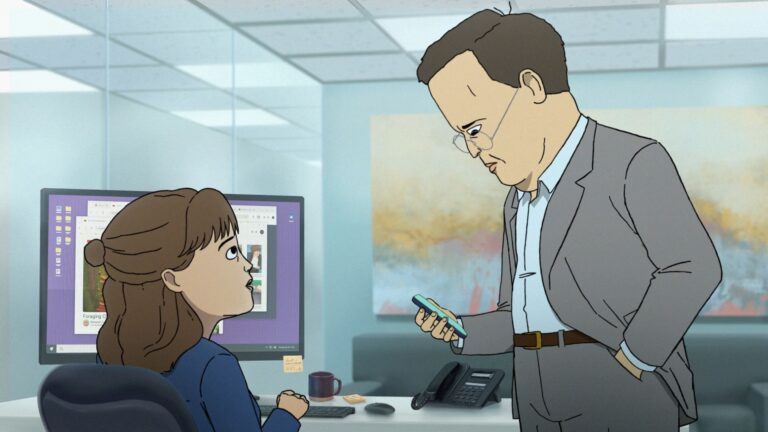Buckle up, Side Effects fans — the world of CSE is a wild, unpredictable ride. No other show on Adult Swim, or frankly anywhere else, dares to waltz through subjects like big pharma corruption, government paranoia, terminal illness, and existential dread — all while tossing out lines sharper than a scalpel and visuals brighter than a fever dream.

A Mushroom, a Shotgun, and a Mission
Let’s rewind to that perfectly weird pilot in February 2025. Remember Marshall and Frances, our awkwardly lovable heroes? Once high school lab partners, now estranged adults, they tumble into the most unlikely road trip after unearthing the mysterious Blue Angel Mushroom. This isn’t just any fungus. Nope. It could cure seemingly anything. Like, literally — one bite and boom, grandma throws away her insulin, or so we’re led to hope.
But that, of course, makes the discovery bigger than either of them. Soon, the full force of a pharma giant (hello, GenaPharm!) and some government heavies descend. The chase is on. Marshall and Frances don’t exactly make the most nimble fugitives, but it works, since neither does anyone on this show. That’s a breath of comedic fresh air if you ask me.
The stakes are real. There’s talk of fleecing millions, shadowy surveillance teams, and layered family trauma. Yet “Common Side Effects” never swan-dives into grimdark for its own sake. Instead, every dramatic splash gets a comic ripple, keeping us smiling, then wincing, then maybe snorting with laughter at our own discomfort.
Why the Comedy Lands
Let’s talk tone. A lot of shows jostle for the “serious issues + laughs” label, but CSE nails it. Tonally, it can whip from harrowing, real-world pharmaceutical manipulation to the goofy problem of a backpack full of sticky, glowing mushrooms. The talking, half-bald crow shouting “You’re all doomed!” should be a joke too far, but somehow, it just fits.
Transitions in the show, much like this article, flow fast. One scene dives deep into the loss and regret eating at Marshall. Next, GenaPharm’s board room explodes in high-stakes posturing — sniping lifted straight out of Martin Shkreli’s worst interviews. The showrunners, Joe Bennett and Steve Hely, revealed they lifted real-life pharma testimony for some dialogue. If you spotted those Shkreli vibes, gold star.
Yet for all these very real, very grim themes — you won’t find CSE wallowing. There’s too much visual sparkle, too much joke-throwing energy, and oddly enough, too much hope in the weirdest places. The show never punches down. Instead, it winks, shrugs, and dares you to laugh at the rational madness of modern life.
Why the Animation Matters (A Lot)
Animation style counts for a ton in this show, and it doesn’t look like anything else airing now. Joe Bennett, fresh off some underground MTV classics, handpicked an international crew to shake up the frame. Their backgrounds pop in “petridish pastels.” The palette pulses. Each scene teeters between surreal and tangible — the world feels grounded, yet slips on its own banana peels. You get breathtaking nature shots, then a jarringly hilarious office montage. The visual DNA runs with the same risks as the writing. That pays off. It’s not just a layer of paint — it’s storytelling.
According to the creators (who spilled all in that gutsy behind-the-scenes interview), drawing the world of CSE wasn’t an afterthought. The surreal bits — the glowing shrooms, the “bleeding edge” surveillance tech, the mutants glimpsed in pharmaceutical halls — are always tethered to reality by tiny, believable character actions. So, Frances picks at her scabs. Marshall mutters apologies to his old lunchbox. The more bizarre things get, the more you can tell the showrunners want us to see ourselves in every oddball protagonist.
How Are People Actually Reacting?
Fans, critics, and even the Twitterati (yes, we still call it Twitter, fight me) have been eating this up. Rotten Tomatoes went bonkers, spitting out a 100% critic score and well over 90% with audiences. Metacritic’s sitting pretty at an 80 for critics, with users bumping it up to 8.3. Most reviewers praise that “compelling blend of suspense, spirituality, understated comedy, and just enough mystery dangling on the hook” (A.V. Club).
Scroll forums, and you’ll see fans gobbling up the offbeat humor. They unpack every cryptic government agent cameo, every dropped reference to real-world pharma disasters, every tiny callback nestled into the backgrounds. I mean, people are writing essays about the symbolism of the crow. People yell about Frances’ therapy sessions being “funnier than Dr. Katz but twice as harrowing.” The meme machine cranks every week — a sure sign a show’s wormed into culture.
Darker Themes, Lighter Touch
But here’s what makes CSE leap ahead of the pack: they get heavy, but never lose their lightness. Sure, terminal illness and systemic corruption are tough going. It’s tempting for shows to let their audience wallow. CSE lets that darkness breathe, sure. But soon enough, Marshall’s anxieties explode into a rant about his father’s sandwich-making habits, or Frances heads all-in on a conspiracy theory involving fluorescent squirrels (she’s only half-kidding).
Even when the world turns bleak, every episode has its tiny rebellion — a sly joke, a line tossed off with just the right timing, a stunned blink from one of those throwaway side characters. The chaos stays chaotic, but somehow you end up laughing through the dread. There is, beneath all the darkly absurd energy, a real warmth.
Social Buzz: Can’t Stop, Won’t Stop
People aren’t just watching — they’re dissecting. The social buzz spins every episode into Twitter threads, TikTok roundups, and long Reddit thinkpieces. One big talking point? GenaPharm’s PR chief, a walking pharma nightmare with a ponytail and a spray tan, delivers lines fans swear they’ve heard in Congressional hearings. (Spoiler: they have. That’s the whole point.)
And the memes never stop. That talking crow? Meme icon. And let’s not sleep on the “CSE Side Effects List”—a running gag where fans list all the accidental, usually hilarious side effects the show’s characters experience. Paranoia about mushrooms. Sudden urges to buy a locked briefcase. The yearning to call your old lab partner and apologize for that thing in high school. Fans love it, and the show only eggs them on with sly meta-jokes.
What Critics Are Saying, but With Fewer Boring Words
Critics do love their words. Yet here, they’re right on. They call the show “unpredictable, insightful, and packed with more laughs-per-minute than any drama you’d spot at 11pm,” according to the Metacritic scores. Most praise the same thing — how CSE wrings insight from the same issues making headlines, without ever falling into simplistic cynicism.
A.V. Club highlights the “compelling blend” of suspense and understated comedy. Variety (yes, the big one) calls the animation “a minor psychedelic, showing us what happens when Adult Swim embraces its weirdest instincts but doesn’t forget the beating heart at the center.” And users seem genuinely surprised that a show about mushrooms, bureaucracy, and existential panic manages to land its jokes as well as its plot twists.
The Showrunners Know What They’re Doing
Everything feels deliberate, never accidental. Bennett and Hely have backgrounds in both animation and sharp, satirical writing (just check the credits). In their official Q&A, they reveal a deliberate choice to splice the real pharmaceutical industry’s horrors with surreal, laugh-out-loud moments. They want “Common Side Effects” to be the rare show that makes viewers both cackle and shudder in quick succession. And so far, it’s working.
What’s Next?
Did you see the season two announcement? The creators are heading global — taking the story far from the U.S., and promising hilariously sinister new funguses, more awkward family reunions, and plenty of new pharma antagonists. International conspiracy, more mushroom mishaps, and character growth with the brakes cut — sounds about right. The fan theories are already spinning, and the creators are clearly in no hurry to answer everything.
So, Why Do We Keep Watching?
That, Side Effects faithful, is the question, right? Maybe it’s the riotous color overload, the relentless jokes, or that gut-punch relatability. Or maybe you stick around because “Common Side Effects” gets it. The world is a mess, sure, but there’s something gleeful about embracing the chaos. And hey, if we can laugh together in the wreckage — whether about corrupt pharma CEOs or mutant glowing mushrooms — maybe we’re all just a little more human for it.
Stay tuned, keep laughing, and don’t eat any mystery mushrooms unless you really know your side effects.




